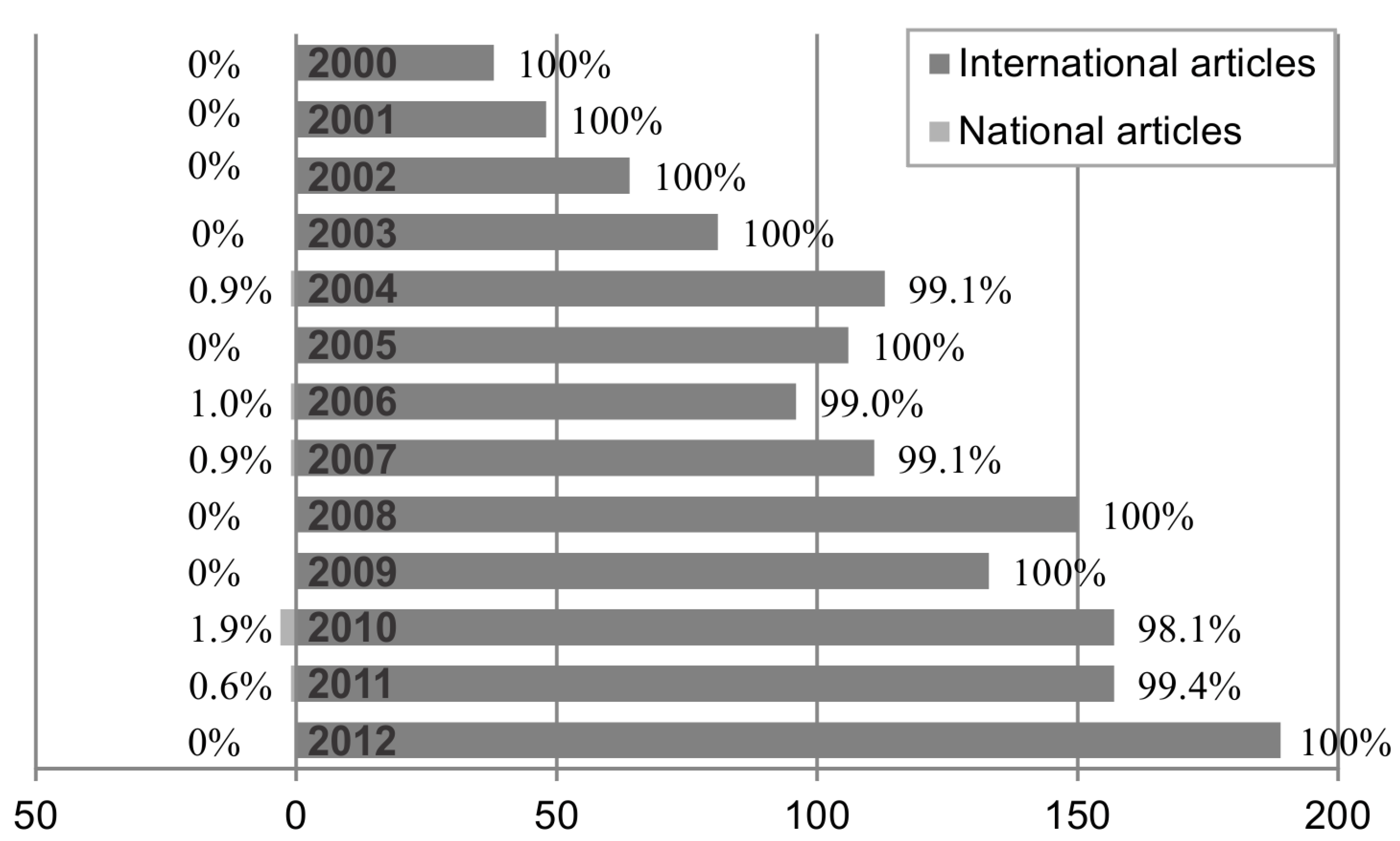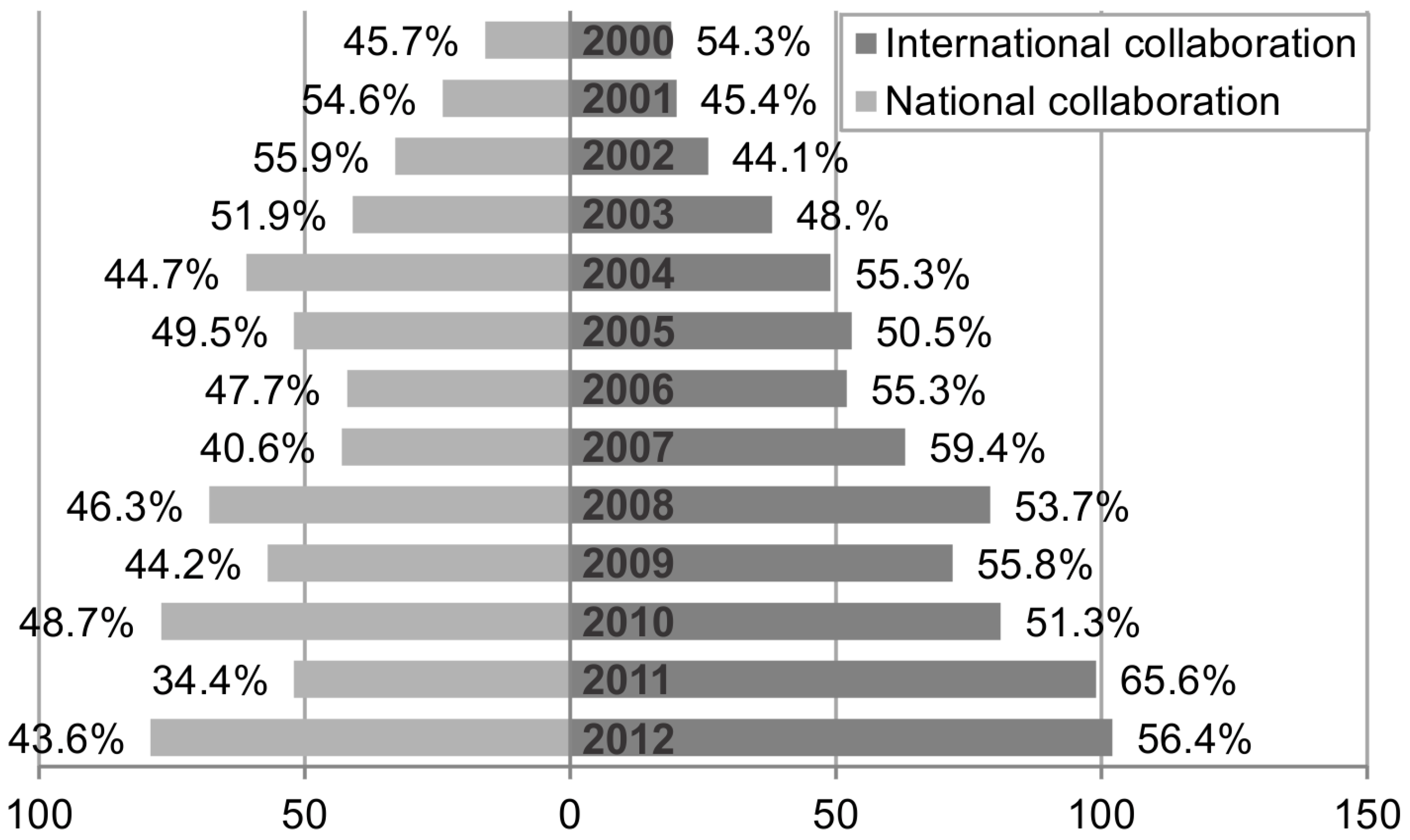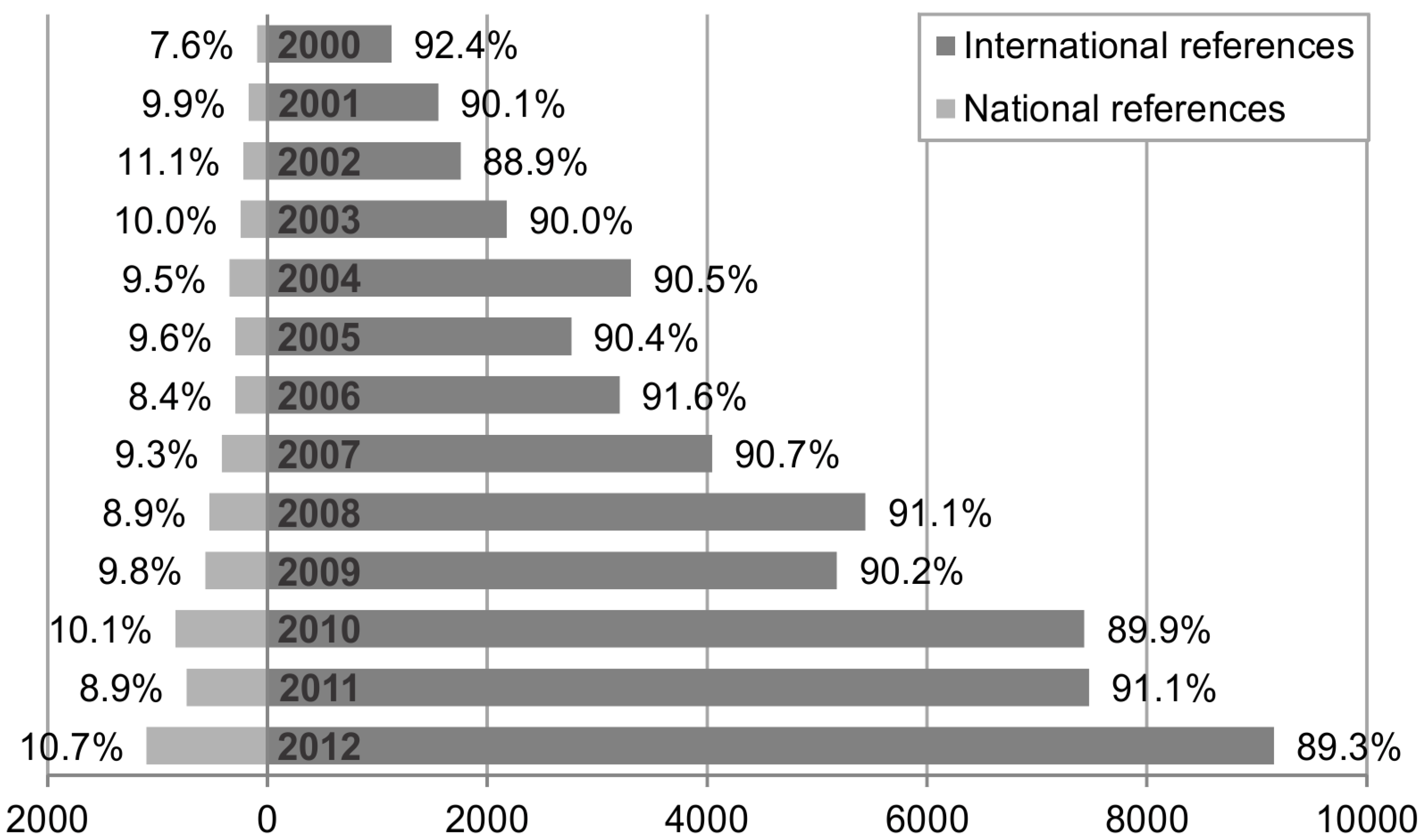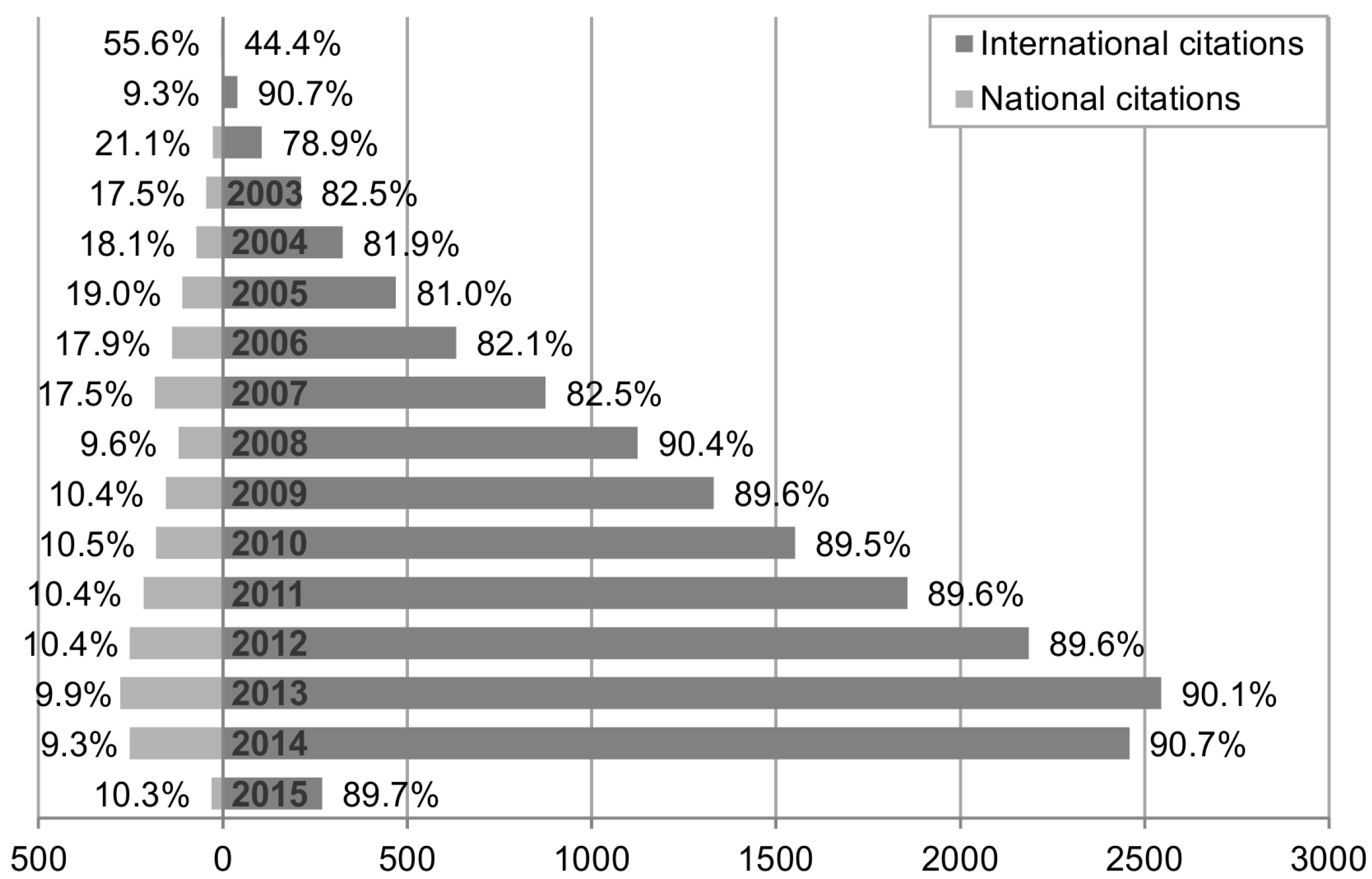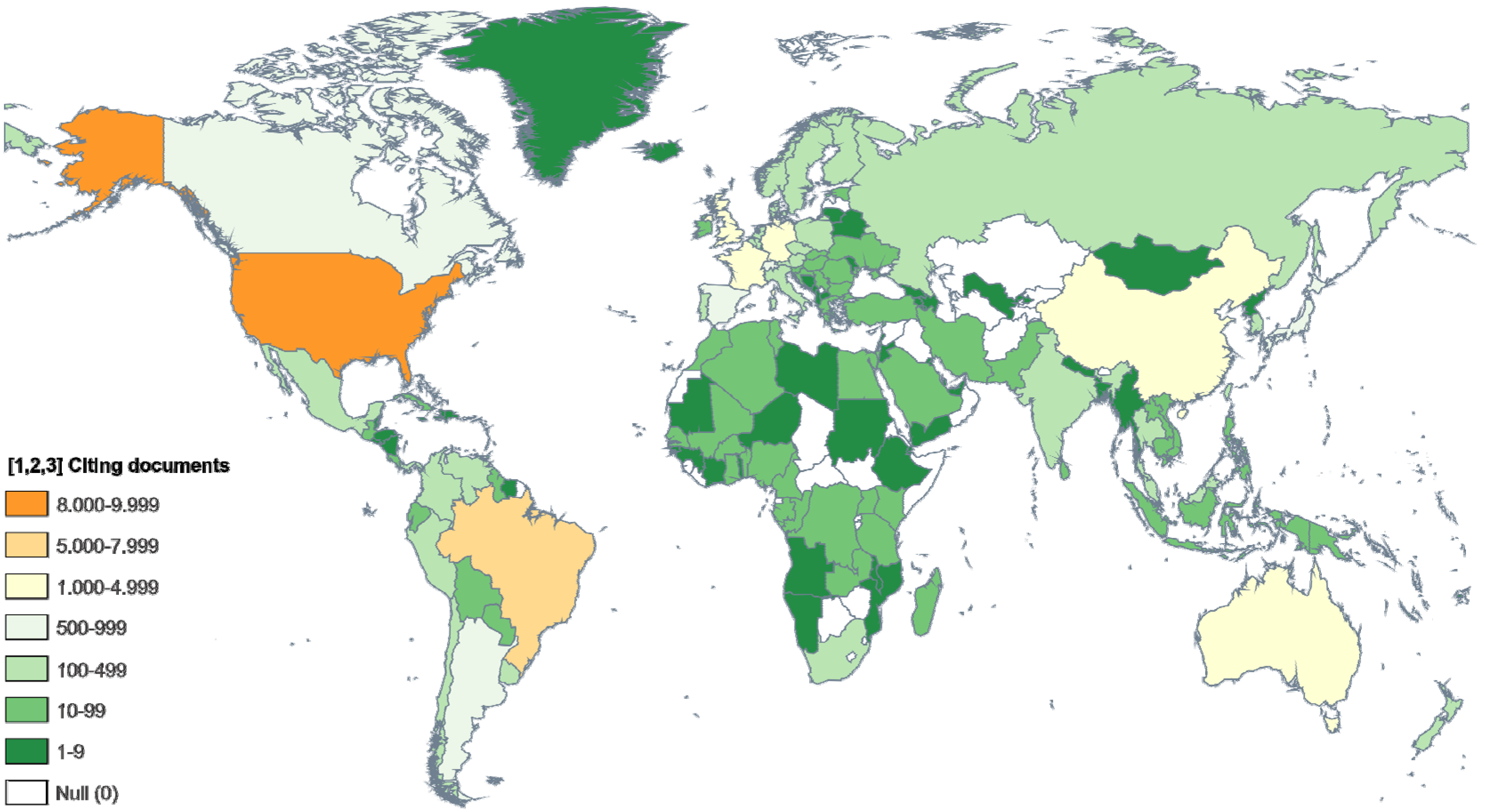1. Introduction
Internationality has significantly impacted contemporary science, especially in developing countries such as Brazil. Despite its recognized importance, there are still few studies that investigate the internationalization of scientific output based on multiple indicators. Previous studies have focused mainly on analyzing the internationality of scientific output through diffusion and collaboration, whereas the internationality of references and citations has been poorly explored in bibliometric studies.
References and citations were studied by Glänzel and Schubert [
1], who evaluated the internationality of documents from 12 branches of knowledge published between 2000 and 2002 by authors from the first 36 countries on the Web of Science (WoS) impact ranking. Results revealed mean rates of 25% of domestic references and 30% of domestic citations in the Brazilian scientific output. The domesticity index for Brazil was higher in regional fields, such as Agriculture, but also in branches of international interest, such as Environment and Engineering, while lower rates were observed for Geosciences and Space Science, Cell Biology and Genetics, and Clinical and Experimental Medicine, indicating greater internationality in these fields.
The same authors also analyzed cross-references and citations from the 36 countries [
2]. Brazil’s three main partners in the cross-references were Argentina, Mexico, and Portugal. The position of the latter two countries is inverted in terms of cross-citation preference, while Argentina remains in the first position. The results indicate that geopolitical location, cultural relations and language determine preferences for cross-citations and references among countries. The United States stands out as the universal preference of several countries, including Brazil, although relationships are not symmetrical in most cases.
Other studies also focused on analyzing the internationality of publications and their citations. Aviles and Ramirez [
3] evaluated internationality in ten Library and Information Science journals based on seven key indicators, including authorship and citations. In Brazil, Meneghini
et al. [
4] investigated the national
versus international orientation of citations received by 13 Brazilian journals indexed in the Scientific Electronic Library (SciElo) and WoS. The authors found that the citations can be grouped into two clusters, and that national audience is as important, if not more so, as the international audience in terms of the scope of publications.
Previous studies have also found that international collaboration influences the impact of publications. Van Raan [
5] analyzed Dutch output in Astronomy published between 1980 and 1993 and found that articles with international co-authorship are more cited than national papers. Glänzel and Schubert [
6] also found evidence of an association between international co-authorship and the impact of international publications on Chemistry in 1995.
Similar results were obtained by the Royal Society [
7] in a study on international collaboration networks in the early 21st century. The study found that, for each author associated with an international article, there is an increase in the number of citations attributed to the publication, although this increase is less evident when ten authors are counted. Adams [
8] assessed overall production over the last three decades (1981–2012) and reported that articles resulting from international collaboration are cited more often. According to the author, international co-authorship not only interferes with publication impact, but also affects the productivity of researchers, institutions and countries and their ability to contribute to global knowledge.
Evolutionary Biology is dedicated to the study of the origin and diversification of life, and the adaptive changes and extinction of living beings. The field emerged in the nineteenth century, with the studies of Lamarck, Darwin and Mendel. In the mid-twentieth century, the discovery of the DNA structure expanded the possibilities of the field with the establishment of a physical basis for Genetics. The emergence of Molecular Biology in the second half of the twentieth century, integrating knowledge from areas such as Biochemistry and Genetics, has also transformed Evolutionary Biology research by providing it with new techniques for solving problems, as well as raising new questions about natural history [
23].
In Brazil, the area has developed especially between the 1930s and 1950s as a result of its approximation with Genetics. At the turn of the millennium, the increase in Brazilian literature from different areas was also reflected in this field, which showed growth rates above the national average. Currently, the Brazilian Evolutionary Biology research is characterized by an international focus, an aspect which is reflected in the patterns of publication and international collaboration and justifies the choice of the area as object of this research.
This article analyzes the national/international character of Brazilian Evolutionary Biology papers published between 2000 and 2012 and indexed on WoS regarding four key aspects: publication, collaboration, references, and citations. The research aims to increase knowledge of publication and collaboration patterns in the area, understand information usage preferences in relation to its national/international nature, verify the national/international audience of research and evaluate the contribution of these indicators to the internationalization of Brazilian science, focusing on Natural Sciences. In addition, the goal is to understand the possible correlation between international co-authorship and the volume of references and citations in articles.
Academic publishing has experienced significant changes in recent decades, including the introduction of Open Access, electronic publishing and the emphasis on the international reach of research results. The internationalization of science generates new patterns of production and use of information and requires new insights of librarians, publishers and academic institutions. Understand international dimensions of scientific production is important not only to define national and institutional scientific policies and propose evaluation parameters, but also to know the patterns of usage and consumption of information by researchers as a way of ensuring access to appropriate sources of information.
The importance of this study also lies in the opportunity to broaden knowledge on the internationalization of Brazilian Evolutionary Biology and provide information for the planning and evaluation of science policies and international cooperation agreements. It is also justified by the pattern of international publication and the high rates of collaboration with other countries identified in Brazilian Evolutionary Biology in previous studies [
9,
10]. Together, the indicators demonstrate the importance of internationality in contemporary scientific knowledge and qualify the area as a predominantly international field.
2. Materials and Methods
This is a macro-level bibliometric study and results are based on bibliographical data extracted from the web version of the WoS Science Citation Index, produced by the Thomson Reuters group. Data collection for articles and references was conducted in December 2013, filtering (search strategy) by country (CU) and limited to the subject category Evolutionary Biology (WC), timespan from 2000 to 2012 (PY), and document type—article. This strategy was combined with a topic search (TS) using the terms Evolutionary Biology OR Biological Evolution, filtering by country and the same timespan. Citation data were collected in March 2015 and obtained from the Create Citation Report icon, available on the result screen from the previous search.
The corpus of the study consists of 1450 articles in the area of Evolutionary Biology published between 2000 and 2012 by at least one Brazilian author; 60,454 references cited by the articles; and 18,059 citing documents, which accounted for 23,480 citations attributed to articles between January 2000 and March 2015. Seventy-five articles (5.1%) did not present any reference in their WoS corresponding records, therefore where not included. This number was reduced to 16 articles (1.1%) in correlation analysis of the reference volume. The timespan (2000–2012) takes into consideration the growth experienced by Brazilian science at the beginning of the millennium. In regard to citations, the window of little more than two years after the publication of the last articles (2000–2015) was adequate and allowed for citation analysis of more recent publications.
Publication patterns and collaboration in the area are assessed according to the publication of articles in international journals and collaboration with authors from other countries, respectively. Although the international nature of journals can also be evaluated by their inclusion in international databases [
11], we opted to assess it according to the publishing country of the journals. It is understood that the origin of the published journals reveals more clearly the diffusion and the international reach of scientific output. International collaboration requires the participation of at least one foreign author in publications, even in collaboration with Brazilian researchers.
References include documents cited by 1450 Brazilian articles, while citations are represented by documents that attribute citations to articles. In other words, the number of references from an article is measured by the number of items that make up its bibliography, while the number of citations refers to mentions in later studies [
12]. References and international citations were defined by the presence of foreign authors in the articles. References and citations that include at least one foreign author in collaboration with Brazilian authors were considered international, whereas documents written solely by Brazilian authors were deemed national. The internationality of references was determined individually for each document using complementary internet sources, since the countries of origin of the authors in the cited references are not provided in the data extracted from WoS.
The WoS fields used in the analysis were: Publisher Address (PA) to identify the countries of origin of journals; Author Address (C1) to identify the country of origin of article authors (national and international collaboration) and citing authors (national and international citations); and Cited References (CR), to obtain article references.
Data processing was performed with the BibExcel, Microsoft Excel, Statistical Package for the Social Sciences (SPSS) and Philcarto software. The relationship between indicators was analyzed using Pearson’s Correlation Coefficient. The pairs of variables used to evaluate the influence of international collaboration on patterns of references and citations in Brazilian Evolutionary Biology were international co-authorship-references and international co-authorship-citations.
3. Results and Discussion
Domesticity and internationality indicators of references and citations are preceded by the analysis of publication and collaboration patterns in the area in Brazil, which express the internationality of articles through diffusion and international collaboration. Relationships between indicators are evidenced in the results and reinforce the importance of combining variables to study the internationalization of scientific output at various aggregation levels [
13,
14].
A preliminary descriptive analysis suggests an upward trend in the number of articles, which rose from 38 in 2000 to 189 in 2012. The 1450 assessed articles account for approximately 0.5% of Brazilian papers from various fields and 2.1% of international papers published by the area in the period. Overall, 60,454 references and 18,059 citing documents were identified, accounting for 23,480 citations attributed to articles between January 2000 and March 2015.
Table 1 shows national and international indicators of Brazilian scientific output based on the following variables: publishing journals, international co-authorship, cited references, and citations received.
The diagrams below show the national and international dimensions of scientific output according to the data presented in
Table 1. The nationality of the indicators is shown on the left in light gray, while internationality is depicted on the right in dark gray. The bar graphs represent the year of article publication (publishing, collaboration and references) and citations (citing documents). The lower axis shows the intervals for the absolute numbers of each variable.
3.1. National and International Publication
The internationalization of articles reveals the ability of researchers to promote the dissemination of study results in the international community [
11].
Figure 1 reveals a strong preference among Brazilian researchers from the field for publishing results in foreign journals. Among 1450 articles, 1443 (99.6%) were published in foreign journals and only seven (0.4%) in Brazilian journals. This characteristic follows the pattern of Biological Sciences in Brazil [
14,
15], which is clearly consolidated in Evolutionary Biology, since almost all articles were published in foreign journals.
Figure 1 clearly shows the international focus of publications. Three international journals contained 472 articles (32.5%) and are the main channels for dissemination of Brazilian output in Evolutionary Biology: Biochemical Systematics and Ecology (United Kingdom), with 231 articles (15.9%); Molecular Phylogenetics and Evolution (United States), with 124 (8.5%); and Plant Systematics and Evolution (Austria), with 117 articles (8.1%). Output is also distributed among six Brazilian and 77 foreign titles, with clear predominance of the English language, identified in 1448 articles (99.9%).
The literature of the Brazilian Evolutionary Biology is absolutely concentrated in international journals. The six national journals identified in the study are from areas of Genetics, General Biology and Biodiversity Conservation. There are no traditional Brazilian journals in this area in Brazil, only in related and broader fields. The international focus of the research and the tradition of publication in international journals probably contribute to the maintenance of this setting in the literature of the field, as well the size of its scientific community and the interface with other areas.
3.2. National and International Co-Authorship
International collaboration is one of the main dimensions of science internationalization, since it reveals an association between countries in collaborative research projects and combines resources and expertise to achieve common goals [
16]. Studies conducted in recent decades show increasing international collaboration rates and signal a rise in the impact potential of articles produced by authors from two or more countries [
5,
6,
7,
8]. While the global average of international coauthoring is close to 35% [
7], this occurs in about 30% of publications in Brazil [
17,
18]. The figure is higher in Evolutionary Biology and reinforces a specific characteristic of the area in the country [
10]. Among the 1450 articles published between 2000 and 2012, 753 (51.9%) have international co-authorship and 645 (44.5%) national co-authorship. The 52 remaining articles (3.6%) were produced by a single author and are therefore not shown in
Figure 2.
Increased international cooperation is evidenced in the graph, gaining strength in the second half of the period and reaching a maximum of 65.6% of articles published in 2011. The high pattern of international collaboration is unusual in Brazilian scientific output and suggests the integration of Evolutionary Biology in global science. The importance of this indicator goes beyond understanding the collaborative framework in science and its international focus, and may influence research practices and the production of knowledge, dissemination of results and the impact of research on the construction of new knowledge.
The importance of international co-authorship as an internationalization indicator in Brazilian Evolutionary Biology suggests the existence of interfaces between the volume of cited references and citations received by articles. With this in mind, we sought to understand the influence of international collaboration on the citation behavior of researchers based on two key questions: does international co-authorship positively contribute to the number of references cited in articles? Does international co-authorship attract more citations for articles than strictly national authorship?
Correlation between the variables “international co-authorship” and “number of references” was 0.264, showing a moderate relationship between the number of countries registered in authorship data and the volume of references, indicating that international collaboration adds more references to articles than exclusively national authorship.
This association suggests that international collaboration influences the citation behavior of researchers and that a partnership between two or more countries can result in relatively wider use of the scientific literature in new papers in the area. This situation is understandable, since authors from different countries can access different information sources and have different training and habits [
19].
The association between the variables “international co-authorship” and “citations” proven in other contexts by Glänzel and Schubert [
6], Persson
et al. [
19] and Tan
et al. [
20], was also moderate in our data, reaching a value of 0.235, which is very similar to the previous result for references. Although the correlation is modest and other studies have identified stronger associations, the results confirm the hypothesis that international collaboration influences the number of citations received by articles. The implicit conclusion is that international collaboration results in greater impact for Brazilian research in Evolutionary Biology, reinforcing the importance of establishing agreements, partnerships and international cooperation for Brazil in this area.
3.3. Nationality and Internationality of References
The rate of international references exceeds 90.0% in most years, with only 9.5% national references, indicating a pattern of international information use in the area. The number of references per article is also an important indicator in this context, because it reflects the social links in science, the stage of discipline development and the conditions of access to information by the scientific community [
12,
21,
22]. The results show a significant increase in the average number of references, rising from 33.9 in 2000 to 55.7 in 2012. This growth becomes more pronounced from 2006 onward and speeds up again in 2010. Factors such as increased internet access in Brazil at the beginning of the millennium, the creation of the CAPES Portal of E-Journals
1 in 2000 (progressively expanded in subsequent years) and the movement for open access to scientific knowledge may have contributed to the increased number of references cited in articles. In addition, it is important to consider the development of the field itself, driven by integration with areas such as Molecular Biology, Biochemistry and Genetics [
23], which has resulted in greater activity and availability of the literature on the subject.
The analysis shows an increase in the number of references over time, accompanying the trend seen in branches of Biochemistry, where the average number of references per article increased from 28.8 in 1970 to 37.0 in 1985 [
24]; of Biodiversity, where the average rose from 40.1 references per article in 2000 to 45.6 in 2009 [
21]; and Bioinformatics, where average references per article varied between 22.4 and 50.9 in 32 journals in 2007 [
25]. The number of references per article is high in Evolutionary Biology and, although growth does not occur indefinitely, it is difficult to predict a saturation phase based on the results, eliminating the possibility of a maximum reference limit [
26]. On the other hand, if we assume that a high number of references reflects citation density and provides clues on social connections in science [
12], we can conclude that Brazilian Evolutionary Biology is a dense and highly connected discipline, reinforcing the results of Santin
et al. [
10] regardin the collaboration framework and dynamics in the field.
The internationality of references does not seem to change significantly with the interference of external factors, remaining constant during the period. The growth of the Brazilian scientific literature is offset by increased international collaboration and does not imply a direct increase in the number of national references. The rise in Brazilian output also has an opposite effect on citation domesticity, since internationality has gained ground and strengthened in recent years.
References cited also contribute to the internationalization of scientific output since they enhance the international status of research and facilitate the dissemination of results in the international community, especially in the digital scenario.
Figure 3 shows the rates of international references in Brazilian articles on Evolutionary Biology. The stability of the data substantiates the existence of a consolidated pattern of international information use as an input for knowledge production in the area.
The authors make references to predominantly international documents (90.5% of international references in the period). The language barrier, especially English, does not seem to significantly influence the choice of sources and citation behavior of Brazilian researchers in Evolutionary Biology, although this factor is relevant in other fields [
27]. The internationality of references is also greater than that observed by Glänzel and Schubert [
1] in the Brazilian scientific literature from 2000 to 2002, characterized by 75% international references, although the criteria defining intentionality are distinct in that study. Even Life Sciences such as Cell Biology and Genetics, Neuroscience and Behavior and Biomedical Research, which traditionally focus on the international perspective, obtained lower values, with internationality rates around 81%, 80% and 77%, respectively. The index closest to those presented here is related to the branch of Clinical and Experimental Medicine, which accounted for 88% of international references.
3.4. Nationality and Internationality of Citations
The international pattern of citations is also stable, with greater emphasis from 2008. The symmetry between international references and citations, in addition to the preference for publication in international journals and practice of international co-authorship [
9,
10], reinforces the consolidated internationalization pattern of Brazilian Evolutionary Biology.
Brazilian articles receive predominantly international citations, accounting for 88.5% of citing documents.
Figure 4 shows the increasing trend in citation internationality over time, with more stable values in recent years approaching those related to references. Overall, the diagrams show a strong pattern of internationality for references and citations in Evolutionary Biology, as well as clear asymmetry between national and international rates (
Figure 3 and
Figure 4).
The data reinforce the unusual internationality pattern in this field of Brazilian science, especially when compared with the results of Glänzel and Schubert [
1]. While similar branches such as Cell Biology and Genetics, Neuroscience and Behavior and Biomedical Research registered respective international citation rates of 74%, 72% and 66%, Evolutionary Biology reached 88.5%. Once again the figure is close to those of Clinical and Experimental Medicine, which recorded 88% international citations, and Geosciences and Space Sciences, which totaled 82% international references from 2000 to 2002.
The relatively lower internationality of citations may indicate the use of information from studies in other fields. Aspects such as a country's size and geographical location did not seem to interfere as significantly in the domesticity of Brazilian Evolutionary Biology as in other areas [
1]. Between January 2000 and March 2015, Brazilian articles were cited in publications in 175 of the 249 WoS subject categories (70.3%), with particular prominence for Evolutionary Biology, with 3818 documents (21.1%); Ecology, with 3325 (18.4%); Genetics and Heredity, with 3170 (17.5%); Biochemistry and Molecular Biology, with 2344 (13.0%); Plant Sciences, with 2333 (12.9%); Zoology, with 2020 (11.2%); and Multidisciplinary Sciences, with 1053 citing documents (5.8%). The results confirm the integration of the area with Biochemistry, Molecular Biology and Genetics [
23] and indicate the existence of a wide audience with regard to the subject areas.
The extent of the reach of publications is also reflected in geographical terms. Brazilian articles on Evolutionary Biology were cited by 151 countries between January 2000 and March 2015, as shown in
Figure 5. The map shows the geographical distribution of the citing documents across the globe and the audience for publications. It should be noted that the same document can be published in co-authorship by two or more countries, so that the values represented do not correspond to the total citing documents.
Most of the citations come from seven major countries: United States, with 9859 (54.6%); Brazil, with 5458 (30.2%); United Kingdom, with 1827 (10.1%); Germany, with 1339 (7.4%); France, with 1213 (6.7%); Australia, with 1023 (5.7%); and China, with 1011 citing documents (5.6%). Nevertheless, there is citation distribution across a group of 25 countries that attributed more than 200 citations to articles, reinforcing internationalization by the geographical distribution of the citing documents. The United States accounts for the largest number of citations attributed to Brazilian articles, surpassing the number of citing documents from Brazil itself. Although the symmetry of the relationship between citing documents from Brazil and the United States could not be evaluated in this study due to a lack of information on the countries of origin of authors in Brazilian article references, there has been widespread use of Brazilian scientific information by American authors, as represented in
Figure 5.
According to Schubert and Glänzel [
2], Argentina, Brazil’s main partner in cross-citations and references in different areas, also plays an important role in Brazilian Evolutionary Biology, despite ranking 10th among countries and gathering 770 citing documents (4.3%). Mexico and Portugal, important partners of Brazil in cross-citations [
2], occupy the 14th and the 22nd positions in terms of citing documents, with 444 and 273 documents, respectively. Once again citation behavior is internationally-oriented, distinguishing Evolutionary Biology from other fields. Geographic location, cultural relations and language do not determine the main citing documents, although they may have different effects on cross-citations between countries.
Another finding was the prominence of international documents among Brazilian citing documents. Among 5458 Brazilian citing documents, 3385 (62.0%) were published in co-authorship with foreign authors, while 2073 (38.0%) had only national authors. For this study, which requires the participation of at least one foreign author to classify publications as international, the percentage of international citing documents is estimated to reach 88.5% when including Brazilian papers written in collaboration with authors from other countries. This proves that citations are predominantly of international origin, and that distribution between national and international audience is not uniform as verified in Brazilian journals [
4], which could be a more balanced situation, as proposed by Glänzel and Schubert [
1]. The international publishing pattern in Evolutionary Biology, with 99.6% of articles published in foreign journals, favors the use of information by an essentially international audience, which, in turn, increases the potential for internationalization of Brazilian science when citations are attributed to publications.
4. Conclusions
Based on the analysis of the results of this study and in line with data from previous research, we have concluded that Brazilian Evolutionary Biology is a predominantly international field, integrated into global science. The international output and publishing patterns, evidenced by the publication of 99.6% of articles in foreign journals and international co-authorship in 51.9% of publications, is strengthened by the use of international documents as input in the creation of new knowledge. While 90.5% of the cited references are international, 88.5% of the citations received come from publications that include at least one foreign author.
In addition to providing clues about the citation behavior of researchers, the results reveal a tendency towards the use of international scientific information in the area. This information is relevant to planning and evaluation of national science policies and to definition of indicators for assessment of scientific activity in the field. It can also indicate strategies for libraries and academic institutions with regard to services to support research and to provide appropriate information sources to researchers according to their needs.
The internationality of output, collaboration and citation is fairly regular in Brazilian Evolutionary Biology, with strong asymmetry between the national and international levels. In absolute numbers, the smallest internationality level recorded is for collaboration, but in relative values, this variable stands out for presenting rates above the national and international average, possibly contributing to the international focus of other indicators. The relationship between international co-authorship and the volume of references and citations was confirmed by Pearson’s Correlation Coefficient, which showed moderate correlation between the two pairs of variables. International collaboration therefore tends to add more references to articles and generate greater impact for the Brazilian scientific output.
Although the articles in this study represent only 0.5% of Brazilian output published between 2000 and 2012, they are undeniably important in the internationalization of the country's science, both by contributing to the expansion of research and in terms of the internationality demonstrated in its scientific output. The internationality of the indicators enhances the dissemination and impact of Brazilian articles on the global stage. The geographical distribution of the citing documents across the globe confirms that publications reach audiences in 151 countries, particularly the United States, Brazil, the United Kingdom, Germany, France, Australia, and China.
Considered alone, none of the indicators used in this study ensures the internationalization of scientific output, since a single criteria may reveal partial aspects of the phenomenon. In addition, internationalization should be evaluated in the context of national strategies and scientific and institutional policies. The internationalization patterns identified in this study are suited to the area and the international focus of its studies. However, these characteristics differ between fields of knowledge and even between the branches of Natural or Biological Sciences. In Evolutionary Biology, internationality patterns have broadened the audience for research results and ensure greater visibility for Brazilian science on the global stage.
